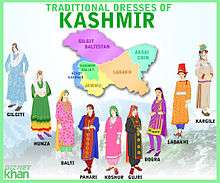Culture of Kashmir

The culture of Kashmir refers to the culture and traditions of Kashmir, a region in northern India (consisting of Jammu and Kashmir), northeast Pakistan (consisting of Azad Kashmir and Gilgit–Baltistan) and the Chinese Occupied territory of Aksai Chin.
The culture of Kashmir is a diverse blend and highly influenced by northern South Asian as well as Central Asian culture. Along with its scenic beauty, Kashmir is famous for its cultural heritage; it amalgamates Muslim, Hindu, Sikh and Buddhist philosophies and has involved composite culture based on the values of humanism and tolerance which is collectively known as Kashmiriyat.[1]
Background
Kashmir

The most important part of the cultural identity of the Kashmiri people is the Kashmiri (Koshur) language. This language is spoken only in the Valley of Kashmir by the Kashmiri Pandits and Kashmiri Muslims. Besides language, Kashmiri cuisine and culture has been greatly influenced by Central Asian and Persian culture. Kashmiri is an Indo-Aryan (Dardic subgroup) language close to Central Asian Avestan-Persian. Cultural music and dance like Wanvun, Rouff, carpet/shawl weaving and Koshur Sufiana forms a very important part of Kashmiri identity. Kashmir has witnessed many spiritual gurus who migrated from their land to Kashmir. Kashmir has also even witnessed the birth of some of the great poets and suifs of all time like Lal Daed, Sheikh-ul-Alam, and many more; and is regarded as Peer Vaer (a place or land of spiritual gurus). It is important to note that Kashmiri culture is predominantly followed only in the Kashmir valley and Doda of the Chenab region. Jammu and Ladakh have their own distinct cultures that are very different from that of Kashmir.
The Dumhal is a famous dance in the Kashmir valley, performed by men of the Wattal region. The women perform the Rouff, another traditional folk dance. Kashmir has been noted for its fine arts for centuries, including poetry and handicrafts. Shikaras, traditional small wooden boats, and houseboats are a common feature in various lakes and rivers across the Valley. Kashmiri culture is defined in terms of religious values, Kashmiri language, literature, cuisine and traditional values of mutual respect. The overwhelming majority of Kashmiris are Muslims and Islamic identity plays a very important role in the daily lives of people. Kashmiris across the religious divide have for centuries shared cordial and friendly ties. Kashmiri poets and writers like Mehjoor, Abdul Ahad Azad, etc. enriched the literature with their poetry. Kashmiri cuisine holds a unique place among different world cuisines. Salted tea or Sheer Chai is the traditional drink and is cooked in a Samavar, a Kashmiri tea-pot. Kashmir has been noted for its fine arts for centuries, including poetry and handicrafts. Shikaras, traditional small wooden boats, and houseboats are a common feature in various lakes and rivers across the Valley. Kehwa, traditional green tea with spices and almond, is served on special occasions and festivals. Kashmiri weddings are regarded incomplete without the Kashmiri traditional food known as Wazwan, which is typically spicy food cooked by the traditional cooks (Waz). Wazwan is a multi-course meal in which almost all the dishes are meat-based.
Ladakh
Culture of Ladakh is famous for its unique Indo-Tibetan culture. Chanting in Sanskrit and Tibetan language forms an integral part of Ladakh's Buddhist lifestyle. Annual masked dance festivals, weaving and archery are an important part of traditional life in Ladakh. Ladakhi food has much in common with Tibetan food, the most prominent foods being thukpa, noodle soup; and tsampa, known in Ladakhi as Ngampe, roasted barley flour. Typical garb includes gonchas of velvet, elaborately embroidered waistcoats and boots, and gonads or hats. People, adorned with gold and silver ornaments and turquoise headgears throng the streets during various Ladakhi festivals.
Jammu
Jammu's Dogra culture and tradition is very different from the Kashmiri culture. The Dogra culture is instead much similar to that of neighbouring Punjab and Himachal Pradesh. Traditional Punjabi festivals such as Lohri and Baisakhi are celebrated with great zeal and enthusiasm throughout the region, along with Accession Day, an annual holiday which commemorates the accession of Jammu & Kashmir to the Dominion of India.[2] After Dogras, Gujjars form the second-largest ethnic group in Jammu. Known for their semi-nomadic lifestyle, Gujjars are also found in large numbers in the Kashmir valley. Similar to Gujjars, Gaddis are primarily herdsmen who hail from the Chamba region in Himachal Pradesh. Gaddis are generally associated with emotive music played on the flute. The Bakkarwalas found both in Jammu and the outskirts of the Vale of Kashmir are wholly nomadic pastoral people who move along the Himalayan slopes in search for pastures for their huge flocks of goats and sheep.
Pakistan
the culture of POK is very similar with the culture of jammu and kashmir .but the language there spoken is 'pahari'(similar to Punjabi) not kashmiri.
Cuisine
Kashmir has a variety of meat based dishes like Rogan Josh, a lamb dish. Wazwan is a multi-course dish which is served on occasions like weddings.
Festivals and observances
there are many festivals that are associated with seasons .
Language and literature
The Kashmiri language is the main language spoken in Kashmir, although many other Indo-Aryan languages are also prevalent. Kashmiri literature has a rich history stretching back to hundreds of years.
Music
References
- ↑ Kashmiri Culture
- ↑ "J-K Accession Day to be celebrated as Diwali: BJP". Rediff. Retrieved 2007-12-31.